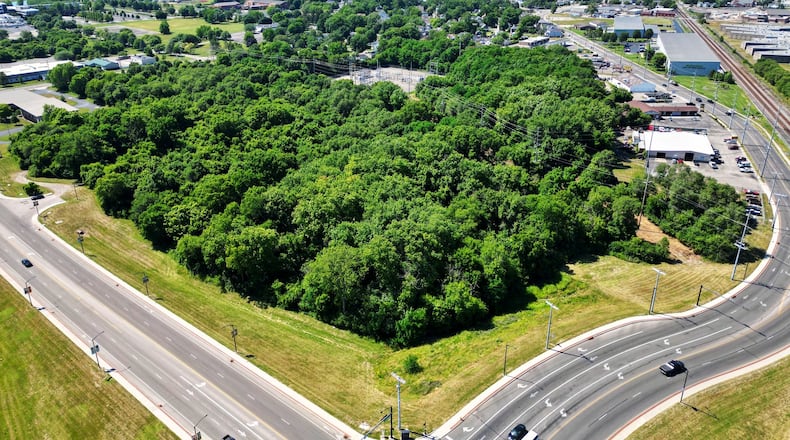A proposed data center in Hamilton is not yet a done deal, though city leaders have been working with the developer for nearly two years.
Public discussions and approvals have helped lay the groundwork for one to be built in the Butler County city. However, there’s much work to be done before a single tree is felled and a shovel turns dirt on a 29-acre parcel of city-owned land.
Hamilton City Council, for its past two meetings, has heard from residents about the proposed data center, collectively saying they don’t want it. Most say they are against it for environmental reasons and the potential noise it could generate.
Others don’t want it because of what they’ve read in communities in other cities and states.
What is a data center?
It is a facility that stores computing infrastructures —servers, network equipment, storage drives, etc. — for digital operations of a company. There are different types of data centers, such as those owned and operated by a single company, rented out by third-party owner, a provider that hosts and managers IT services for clients, and cloud providers such as Google, Meta and Amazon Web Services.
Data centers have roots in the 1980s when personal computers started to populate home offices and living rooms. They began to populate as internet connectivity, which grew exponentially after 2000.
DataCenterMap.com indicates there are more than 4,000 data centers across the country, and 191 are in Ohio. However, Statista.com indicates that as of March 2025, there are more than 5,400 in the United States, which is more than the next 29 countries.
Primary complaints include the energy consumed to operate centers and the water needed to cool generators, according online media reports. Other complaints involve using diesel for backup generators during any power disruption.
Credit: Michael D. Pitman
Credit: Michael D. Pitman
Hamilton proposal
Last year, the city of Hamilton inked a development agreement with Logistix Property Group on a proposed data center on 29 acres of vacant city-owned land on University Boulevard that also fronts Grand Boulevard.
While the land is undeveloped, it has long been a problem for the city. For years, it has been an illegal dumping site of tires, construction debris and other waste. The property has also been identified as a key property in Hamilton’s newly created Innovation District that includes land along the eastern side of the Great Miami River and the Miami University Hamilton campus.
The proposed data center is expected to be a two-story, 320,000-square-foot center, according to Logistix. However, company officials said they have not contracted any end users, therefore details like the number of jobs and the exact amount of power needed is not known at this time.
Logistix officials said it is a potential $1 billion-plus project that could require as much as 240 megawatts of power. City leaders said during conversations with the developer that the amount of power could be significantly less, based on the user.
A third-party company is conducting a facility study and system impact study which is analyzing whether a new data center could be served at the site.
New information won’t be known for at least 90 days from now, when the studies are completed and the results are presented to City Council at a public meeting.
“It’s very early and we’re still gathering information, and we don’t have the information necessary for a decision on this project, either by the developer or by the city,” said Bucheit. “Nothing else will happen between now and getting this information back.”
When that new information is known, the city manager said it will tell Hamilton leaders the amount of power the city could provide to the site and the necessary infrastructure needed to supply the power, and both the studies and the construction of the infrastructure will be on the end-user’s dime.
At the end of the day, Bucheit said a decision will be made only after they know the benefits and costs, and that takes time to learn with “such a complicated issue” that has “so many layers to it.”
What the city won’t do is to turn a way a business looking to invest in Hamilton without any due diligence. The data center industry isn’t just going to go away, he said, “All they’re going to do is move down the road.”
But this will not financially hurt the city of Hamilton electric users, Bucheit said.
Why this won’t raise Hamilton’s rates
Hamilton is the only city in Ohio that owns four major utilities, which includes electric. While other communities with data centers have seen residents with rising electric bills, Bucheit said that’s not happening in Hamilton due to its “unique position.”
On average, the city produces about 95% of its electric needs throughout the year, with the remaining 5% bought on the open market. That open-market purchase is made when demand is high, such as during a hot summer when home AC units are blasting cool air.
When the power is not in high demand, like in the spring and fall, the city will produce more than enough power.
While data centers would impact utility costs, they won’t have nearly as great an impact on Hamilton as they would only impact roughly 5% of the power portfolio. Anywhere else, the impact is spread across the entirety of a community’s power portfolio.
There is less demand for open-market electricity in Hamilton than anywhere else in the state.
“We’ve been clear with the developer from the very beginning that they have to pay their own way,” said Bucheit. “They have to pay for the cost to study this. They have to pay for any costs for infrastructure upgrades or improvements, and they have to pay for the full cost of any power they consume.”
That power will come from the open market.
According to the city, if the data center project moves forward, a contract called an Electric Service Agreement will be created. This document will lay out their electric rates and electrical payment expectations. This agreement will prevent a data center’s electric costs from being subsidized by local residents and businesses.
However, this proposed Hamilton data center would require significantly less power than what’s proposed in Trenton.
Credit: Nick Graham
Credit: Nick Graham
Trenton data center
A proposed data center in Trenton would be on a 141-acre site. The owner of the property, Prologis, has plans to develop, construct and operate a 1 million-square-foot data center on the property, according to city documents.
Trenton Planning Commission earlier this year updated its zoning code to allow data centers in the city. The land, previously owned by the city, is within the Trenton Industrial Park near Kennel and Woodsdale roads, just east of Molson Coors Beverage Company.
Trenton City Manager Marcos Nichols said there have been some environmental impact concerns and increased utility cots have been raised, but didn’t elaborate on specifics. However, a common complaint is the noise — which is caused by generators.
How much data will be processed at the proposed Trenton facility isn’t exactly known, but the city manager said “projects of this nature allow for job creation and workforce development with the construction of the facility and once operational will support skilled positions in IT, maintenance and facility management.“
Additionally, a project like this would add value to the city’s revenue stream, Nichols said, “and strengthens our reputation as a forward-looking City and helps attract additional technology-driven investment and innovation.”
The Trenton project is expected to create between 100 and 150 full-time jobs, which is more than Hamilton’s projections. The Logistix project, for which the exact number of jobs has not been determined, is estimated to create 50 to 100 permanent jobs.
The jobs in Hamilton are also reported to have a projected salary range of $75,000 to $90,000.
Bucheit said the tax revenue impact is where the city could see larger revenue amounts that could be the equivalent of “hundreds, or even thousands, of jobs.” That exact impact won’t be known until the type of end user would be identified.
New Albany data centers
Greater Columbus has become the data center capital of Ohio with more than 120 data centers in that region. The city of New Albany, which is about 15 miles northeast of Columbus, has 15 data center companies in the New Albany International Business Park. These companies have developed at least 24 of the 45 anticipated buildings, according to the city.
The first data center was operational in New Albany in 2010 and most of the large hyperscale data centers began in 2017. Until September, the city received two noise complaints, both of which were mechanical in nature and resolved within days, said Jennifer Chrysler, New Albany director of Community Development.
“We have several data centers that are located next to residential neighborhoods with no complaints,” she said. “There is typically more noise from manufacturers within the business park than from data centers.”
However, she said, in July, a company commissioned a newly designed data center that has generated noise outside of the property line. In September, the city received several complaints from residents. Chrysler said the company has been responsive to the issue and has contracted with two mechanical engineering firms and a firm to measure sound while they investigate and mitigate the issue.
In the meantime, she said, the company has taken interim steps to lessen the impact as it works towards a permanent solution.
Chrysler said the data center businesses in New Albany “have been great partners in the community.”
“They go beyond the standard for construction and once in the community support the community (schools, programs, etc.) philanthropically,” she said. “Meta sponsors a community action grant twice a year that is open to New Albany and the greater community. Grants have included helping a school district in the area achieve 1:1 computer-to-student technology ratio and purchasing a truck for the food pantry.
AWS recently sponsored a portion of the new fieldhouse built by the Joint Parks District.
Data center concerns
The Columbus area has seen concerns with the amount of water use, according to the Ohio Capital Journal. It reports data centers can consume upward of 5 million gallons a day, and data centers use large amounts of PFAS compounds, or “forever chemicals,” are linked to a variety of health problems.
It’s unknown the environmental impact the type of end user could have since one has not been announced by Logistix. It’s also uncertain if this data center would need to consume 30 megawatts of power or upwards of 240 megawatts of power, as city officials said that range had been discussed with the developer.
Bottomline, residents oppose the data center because of the potential harm, and the city benefiting from that potential harm.
The city established an FAQ page addressing residential questions as they arise, and Bucheit said that page is continually updated when they learn answers to questions. During an Oct. 8 City Council meeting, Hamilton resident Raquel Fantoni said she wants the city to provide more information to residents.
“I see a lot of vague promises of benefit and a lot of assurance about mitigating concerns without getting data to substantiate these claims,” Fantoni told the council. “I am not against profit, but I am against profiting off harm to Hamilton residents, and I have yet to be assured that this could be prevented.”
Data center locations: Hamilton and Trenton
- In Hamilton, the data center will be at University Commerce Park, on a 29-acre site at 1380 University Blvd.
- In Trenton, the data center will be 141 acres at Trenton Industrial Park, east of Woodsdale Road and near the Molson Coors brewery.





